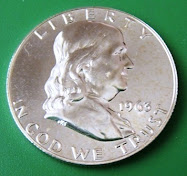1. The dollar is ready to "hyper-inflate" into history. The more they print, the less valuable it becomes. Precious metals are the favorite "safe-haven" when inflation hits.
2. Gold is over $1,000 per ounce...and out of reach for most investors!
3. Silver is very portable and can be easily stored and moved at a moment's notice.
4. The stock market has lost almost 50% of its value in the last year! That means if you had $100,000 invested a year ago, you now have $50,000 left!
5. The bond market has lost a lot of money!
6. Do we need to talk about "real-estate"?
So, that leaves you with 2 Options left...Gold or Silver!
These are desperate times. With many desparate people out there trying to get a hold of your money. Why trust a mutual fund, a bank, or a friend with your money when you can manage it yourself! Silver makes this both affordable and possible.
__________________
When Buying Silver you should consider the following:
1. Is the money you are using "qualified" money currently in an IRA, Keogh, Roth IRA, 401K or other investment? If so, please visit my website.
2. What is the best form of silver to purchase? Again, see the above link.
3. What is the safest way to store it? Ditto
4. How do I liquidate it when I am ready to sell?
These questions and more are answered in this link. But, you better hurry! The dollar will shortly tank and then both precious metals will be unreachable for the average investor. Remember the best time to buy anything is when the price is at an all-time low. The best time to sell is when the price goes up!
Don't miss out on this once in a lifetime investment opportunity! Click Here for more...
---------
Silver is a very ductile and malleable (slightly harder than gold) monovalent coinage metal with a brilliant white metallic luster that can take a high degree of polish. It has the highest electrical conductivity of all metals, even higher than copper, but its greater cost and tendency to tarnish have prevented it from being widely used in place of copper for electrical purposes. Despite this, 13,540 tons were used in the electromagnets used for enriching uranium during World War II (mainly because of the wartime shortage of copper).[1][2] Another notable exception is in high-end audio cables.[3]
Among metals, pure silver has the highest thermal conductivity[4] (the non-metal diamond and superfluid helium II are higher) and one of the highest optical reflectivity.[5] (Aluminium slightly outdoes silver in parts of the visible spectrum, and silver is a poor reflector of ultraviolet light). Silver also has the lowest contact resistance of any metal. Silver halides are photosensitive and are remarkable for their ability to record a latent image that can later be developed chemically. Silver is stable in pure air and water, but tarnishes when it is exposed to air or water containing ozone or hydrogen sulfide to form a black layer of silver sulfide which can be cleaned off with dilute hydrochloric acid.[6] The most common oxidation state of silver is +1 (for example, silver nitrate: AgNO3); in addition, +2 compounds (for example, silver(II) fluoride: AgF2) and the less common +3 compounds (for example, potassium tetrafluoroargentate: K[AgF4] ) are known.
------------------
Jewelry and silverware

Jewellery and silverware are traditionally made from sterling silver (standard silver), an alloy of 92.5% silver with 7.5% copper. In the US, only an alloy consisting of at least 92.5% fine silver can be marketed as "silver". Sterling silver is harder than pure silver, and has a lower melting point (893 °C) than either pure silver or pure copper.[6] Britannia silver is an alternative hallmark-quality standard containing 95.8% silver, often used to make silver tableware and wrought plate. With the addition of germanium, the patented modified alloy Argentium Sterling Silver is formed, with improved properties including resistance to firescale.
Sterling silver jewelry is often plated with a thin coat of .999 fine silver to give the item a shiny finish. This process is called "flashing". Silver jewelry can also be plated with rhodium (for a bright, shiny look) or gold.
Silver is a constituent of almost all colored carat gold alloys and carat gold solders, giving the alloys paler color and greater hardness.[14] White 9 carat gold contains 62.5% silver and 37.5% gold, while 22 carat gold contains up to 8.4% silver or 8.4% copper.[14]
Historically the training and guild organization of goldsmiths included silversmiths as well, and the two crafts remain largely overlapping. Unlike blacksmiths, silversmiths do not shape the metal while it is red-hot but instead, work it at room temperature with gentle and carefully placed hammerblows. The essence of silversmithing is to take a flat piece of metal and by means of different hammers, stakes and other simple tools, to transform it into a useful object.[15]
While silversmiths specialize in, and principally work, silver, they also work with other metals such as gold, copper, steel, and brass. They make jewellery, silverware, armour, vases, and other artistic items. Because silver is such a malleable metal, silversmiths have a large range of choices with how they prefer to work the metal. Historically, silversmiths are mostly referred to as goldsmiths, which was usually the same guild. In the western Canadian silversmith tradition, guilds do not exist; however, mentoring through colleagues becomes a method of professional learning within a community of craftspeople.[16]
Silver is cheaper than gold, though still valuable, and so is very popular with jewelers who are just starting out and cannot afford to make pieces in gold, or as a practicing material for goldsmith apprentices. Silver has also become very fashionable, and is used frequently in more artistic jewellery pieces.
Traditionally silversmiths mostly made "silverware" (cutlery, table flatware, bowls, candlesticks and such). Only in more recent times has silversmithing become mainly work in jewellery, as much less solid silver tableware is now handmade.
Silver is used for awards medals, denoting second place. Some high-end musical instruments are made from sterling silver, such as the flute. (Source)
------------------------
Medicinal

Silver ions and silver compounds show a toxic effect on some bacteria, viruses, algae and fungi, typical for heavy metals like lead or mercury, but without the high toxicity to humans that are normally associated with these other metals. Its germicidal effects kill many microbial organisms in vitro, but testing and standardization of silver products is difficult.[20]
Hippocrates, the "father of medicine",[21] wrote that silver had beneficial healing and anti-disease properties, and the Phoenicians used to store water, wine, and vinegar in silver bottles to prevent spoiling. In the early 1900s people would put silver dollars in milk bottles to prolong the milk's freshness.[22] Its germicidal effects increased its value in utensils and as jewellery. The exact process of silver's germicidal effect is still not entirely understood, although theories exist. One of these is the oligodynamic effect, which explains the effect on microorganisms but would not explain antiviral effects.
Silver is widely used in topical gels and impregnated into bandages because of its wide-spectrum antimicrobial activity. The anti-microbial properties of silver stem from the chemical properties of its ionized form, Ag+. This ion forms strong molecular bonds with other substances used by bacteria to respire, such as molecules containing sulfur, nitrogen, and oxygen.[23] When the Ag+ ion forms a complex with these molecules, they are rendered unusable by the bacteria, depriving them of necessary compounds and eventually leading to the bacteria's death.
Silver compounds were used to prevent infection in World War I before the advent of antibiotics. Silver nitrate solution use continued, then was largely replaced by silver sulfadiazine cream (SSD Cream),[24] which generally became the "standard of care" for the antibacterial and antibiotic treatment of serious burns until the late 1990s.[25] Now, other options, such as silver-coated dressings (activated silver dressings), are used in addition to SSD cream. However, the evidence for the effectiveness of such silver-treated dressings is mixed and although the evidence is promising it is marred by the poor quality of the trials used to assess these products.[26][27] Consequently a major systematic review by the Cochrane Collaboration found insufficient evidence to recommend the use of silver-treated dressings to treat infected wounds.[27]
There has been renewed interest in silver as a broad-spectrum antimicrobial agent. One application has silver being used with alginate, a naturally occurring biopolymer derived from seaweed, in a range of products designed to prevent infections as part of wound management procedures, particularly applicable to burn victims.[28] The year 2007, saw the first antibacterial glass introduced to fight hospital-caught infection: it is covered with a thin layer of silver.[29] In addition, the U.S. Food and Drug Administration (FDA) has recently approved an endotracheal breathing tube with a fine coat of silver for use in mechanical ventilation, after studies found it reduced the risk of ventilator-associated pneumonia.[30]
Another example uses the known enhanced antibacterial action of silver by applying an electric field. It was found recently that the antibacterial action of silver electrodes is greatly improved if the electrodes are covered with silver nanorods.[31]
Silver is commonly used in catheters. Silver alloy catheters are more effective than standard catheters for reducing bacteriuria in adults in hospital having short term catheterisation. This meta-analysis clarifies discrepant results among trials of silver-coated urinary catheters by revealing that silver alloy catheters are significantly more effective in preventing urinary tract infections than are silver oxide catheters. Though silver alloy urinary catheters cost about $6 more than standard urinary catheters, they may be worth the extra cost since catheter-related infection is a common cause of nosocomial infection and bacteremia.[32]
Various silver compounds, devices to make homeopathic solutions and colloidal silver suspensions are sold as remedies for numerous conditions. Although most colloidal silver preparations are harmless, there are cases where excessive use led to argyria over a period of months or years.[33] High doses of colloidal silver can result in coma, pleural edema, and hemolysis.[34] (source)



![[Most Recent Quotes from www.kitco.com]](http://www.kitconet.com/charts/metals/silver/tny_ag_en_usoz_2.gif)
![[Most Recent Quotes from www.kitco.com]](http://www.kitconet.com/charts/metals/silver/t24_ag_en_usoz_2.gif)

No comments:
Post a Comment